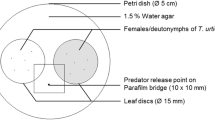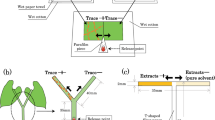Abstract
Reproductive success and population growth of an herbivorous mite are limited by activities of phytoseiid predators. However, occurrences on upper versus lower leaf surfaces are sometimes mismatched between these prey and predators. The mismatch potentially mitigates predation risk for the prey species. We assessed factors that affect mite distributions on leaf surfaces, testing whether the presence of the phytoseiid mite Phytoseius nipponicus alters the leaf-surface distribution and reproductive success of the herbivorous false spider mite Brevipalpus obovatus. The host plant was Viburnum erosum var. punctatum (Adoxaceae). Leaves were set in natural (TRUE) and reversed (upside down; INVERTED) orientations using experimental devices. Both surfaces were accessible to mites. We detected lower and abaxial leaf-surface preferences in P. nipponicus. In contrast, upper and adaxial surfaces were preferred by B. obovatus. Thus, prey and predatory mites accumulated on different sides of leaves. Presence of the predator also indirectly decreased egg production in B. obovatus. Brevipalpus obovatus females actively avoided leaf surfaces with elevated predator numbers; these females shifted their distributions and changed oviposition sites to leaf surfaces with fewer predators. In consequence, B. obovatus eggs on the upper sides of leaves were less frequently preyed upon than were those on lower sides. We suggest that upper leaf-surface exploitation in this particular herbivorous mite species mitigates predation risk from phytoseiid mites, which prefer lower leaf surfaces.




Similar content being viewed by others
References
Broström G, Holmberg H (2011) glmmML: Generalized linear models with clustering. version 0.81-8
Chien JC, Sussex IM (1996) Differential regulation of trichome formation on the adaxial and abaxial leaf surfaces by gibberellins and photoperiod in Arabidopsis thaliana (L.) Heynh. Plant Physiol 111:1321–1328
Ehara S, Gotoh T (eds) (2009) Colored guide to the plant mites of Japan. Zenkoku Noson Kyoiku Kyokai, Tokyo, 349 p. (in Japanese)
Foott WH (1963) Competition between two species of mites. II. Factors influencing intensity. Can Entomol 95:45–57
Jeppson LR (1975) Chapter 2. Population ecology. In: Jeppson LR, Keifer HH, Baker EW (eds) Mites injurious to economic plants. University of California Press, Berkeley, California, pp 17–46
Kasai A, Yano S, Takafuji A (2005) Prey–predator mutualism in a tritrophic system on a camphor tree. Ecol Res 20:163–166. doi:10.1007/s11284-004-0030-9
Krips OE, Kleijn PW, Willems PEL, Gols GJZ, Dicke M (1999) Leaf hairs influence searching efficiency and predation rate of the predatory mite Phytoseiulus persimilis (Acari: Phytoseiidae). Exp Appl Acarol 23:119–131. doi:10.1023/A:1006098410165
Loughner R, Wentworth K, Loeb G, Nyrop J (2010) Leaf trichomes influence predatory mite densities through dispersal behavior. Entomol Exp Appl 134:78–88. doi:10.1111/j.1570-7458.2009.00939.x
McMurtry JA, Croft BA (1997) Life styles of phytoseiid mites and their roles as biological control agents. Annu Rev Entomol 42:291–321. doi:10.1146/annurev.ento.42.1.291
Norton AP, English-Loeb G, Belden E (2001) Host plant manipulation of natural enemies: leaf domatia protect beneficial mites from insect predators. Oecologia 126:535–542. doi:10.1007/s004420000556
O’Dowd DJ, Willson MF (1989) Leaf domatia and mites on Australasian plants: ecological and evolutionary implications. Biol J Linn Soc 37:191–236. doi:10.1111/j.1095-8312.1989.tb01901.x
Ohtsuka K, Osakabe Mh (2009) Deleterious effects of UV-B radiation on herbivorous spider mites: they can avoid it by remaining on lower leaf surfaces. Environ Entomol 38:920–929. doi:10.1603/022.038.0346
Onzo A, Sabelis MW, Hanna R (2010) Effects of ultraviolet radiation on predatory mites and the role of refuges in plant structures. Env Entomol 39:695–701. doi:10.1603/EN09206
R Development Core Team (2009) R: A language and environment for statistical computing, version 2.10.1. R Foundation for Statistical Computing, Vienna
Roda A, Nyrop J, English-Loeb G, Dicke M (2001) Leaf pubescence and two-spotted spider mite webbing influence phytoseiid behavior and population density. Oecologia 129:551–560. doi:10.1007/s004420100762
Sakai Y, Osakabe Mh (2010) Spectrum-specific damage and solar ultraviolet radiation avoidance in the two-spotted spider mite. Photochem Photobiol 86:925–932
Sudo M, Osakabe M (2011) Do plant mites commonly prefer the underside of leaves? Exp Appl Acarol 55:25–38. doi:10.1007/s10493-011-9454-4
Sudo M, Nishida S, Itioka T (2010) Seasonal fluctuations in foliar mite populations on Viburnum erosum Thunb. var. punctatum Franch. et Sav. (Adoxaceae) and sympatric shrubs in temperate secondary forests in western Japan. Appl Entomol Zool 45:405–415. doi:10.1303/aez.2010.405
Suzuki T, Watanabe M, Takeda M (2009) UV tolerance in the two-spotted spider mite, Tetranychus urticae. J Insect Physiol 55:649–654
van Haren RJF, Steenhuis MM, Sabelis MW, de Ponti OMB (1987) Tomato stem trichomes and dispersal success of Phytoseiulus persimilis relative to its prey Tetranychus urticae. Exp Appl Acarol 3:115–121. doi:10.1007/BF01270473
Weintraub PG, Kleitman S, Alchanatis V, Palevsky E (2007) Factors affecting the distribution of a predatory mite on greenhouse sweet pepper. Exp Appl Acarol 42:23–35
Acknowledgments
We thank Prof. H. Amano, Dr. S. Yano and Mr. Y. Sakai, Kyoto University for valuable suggestions. This study was partially supported by Grant-in-Aid for JSPS Fellows No. 23.2696 to SM from Japan Society for the Promotion of Science (JSPS).
Author information
Authors and Affiliations
Corresponding author
Rights and permissions
About this article
Cite this article
Sudo, M., Osakabe, M. Geotaxis and leaf-surface preferences mitigate negative effects of a predatory mite on an herbivorous mite. Exp Appl Acarol 59, 409–420 (2013). https://doi.org/10.1007/s10493-012-9622-1
Received:
Accepted:
Published:
Issue Date:
DOI: https://doi.org/10.1007/s10493-012-9622-1




